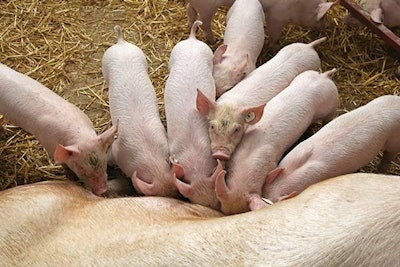
While the productivity of breeding sows has improved significantly, maximizing longevity is an increasing challenge. There are many reasons for sows to be culled but skeletal problems are a common cause. Due to the demands on the sow's body during gestation and lactation, her mineral reserves can be depleted. This can lead to osteoporosis and, in turn, fractures, paralysis, lameness, foot and leg problems. For this reason it is essential to match diets to requirements. This problem is not exclusive to sows; the bone health of boars is also important to ensure effective matings, as mineral nutrition also plays a significant role in fertility.

Body mineral status is also important for boars to optimize performance and fertility. Allnaturalbeth | Dreamstime.com
The addition of phytase to pig diets is known to improve calcium (Ca) and phosphorus (P) digestibility, the two minerals that are particularly important for bone health. If dietary availability is increased, then stores in bone are likely to be higher. The use of phytase is therefore a potentially useful strategy for improving bone health and hence longevity of pigs.
Nutrition of breeding sows
This article follows on from my piece on feeding hyperprolific sows in terms of highlighting the nutritional needs of these animals. Producing and rearing piglets takes its toll on the bodies of sows, particularly if they have not received adequate nutrition. The effect is cumulative over parities, and a larger number of piglets per sow increases this pressure. Sow turnover rates of 30-45 percent have been reported.
Mineral nutrition
The bone mineral reserves of breeding sows after three parities are lower than those of non-reproducing gilts. This is particularly the case for calcium and phosphorus, low levels of which are the main cause of skeletal problems. There was a reduction of 15 to 20 percent in these minerals, the effect being greater in highly productive sows.
Late gestation and lactation are the key times when the sow is using up her body reserves. Growth rates of fetal piglets increase significantly during late gestation, which requires calcium and phosphorus. Similarly there is an increased requirement for these minerals during lactation. When demand is high, minerals can be removed from bone, compromising skeletal integrity. This is the reason why "downer sows" are seen in late lactation. As well as the skeletal problems already listed, bone demineralization can indirectly cause reproductive failure.
Calcium and phosphorus digestibility
The benefits of adding phytase to diets for growing pigs are well known. However, the application in gestation and lactation diets can also improve herd profitability. Improved digestibility and availability of calcium and phosphorus in sow diets has a positive effect on sow performance. There are also savings in terms of feed costs to be made.
A trial in pregnant sows demonstrated the effect of phytase in breaking down phytate and improving calcium and phosphorus digestibility by 10.5 and 23.5 percent respectively. A similar study demonstrated the same effect during lactation (Figure 1). This is a critical period for the sow, when it can be difficult to increase feed intake enough to meet her and her piglets' requirements. The use of phytase could therefore reduce the risk of bone demineralization in sows. The addition of phytase at twice or four times the standard dose has been seen to have even greater effects on calcium and phosphorus digestibility.

Phytase has been shown to significantly improve calcium and phosphorus digestibility in lactating sows.
Bone mineral status
An experiment was carried out last year to evaluate the effect of two doses of phytase on the health and performance of entire males. Bone samples were evaluated in terms of weight and mineralization. A linear relationship between bone ash (p<0.1) and digestible phosphorus levels was observed. There was also a significant effect of a double dose of phytase, compared to negative control on bone ash and bone phosphorus (p<0.05) (Table 1.). Two trials in growing pigs (35kg to slaughter) have demonstrated the effects of increasing doses of phytase on bone mineral status. The phosphorus and calcium content of bone increased with phytase dose, which is turn strongly correlated to performance.

A double dose of phytase increased bone mineralization and phosphorus (P) content of male pigs.
Conclusions
Maintaining body mineral reserves over parities is important for breeding sows to ensure longevity. The optimum number of parities to maximize profitability has been calculated as five. In order to ensure the health and productivity of sows over that time, nutritional strategies need to be employed. As well as adequate intakes of energy and protein, particular attention should be given to mineral nutrition.
The use of phytase to increase the availability of calcium and phosphorus is a useful tool to improve bone mineralization. This in turn could help to reduce the risk of animal being culled due to skeletal problems. The cost and risk of having to introducing replacement pigs into the herd being evident.

















